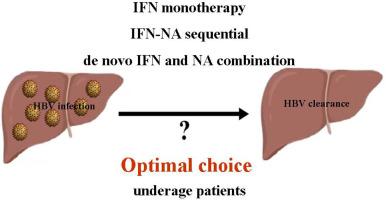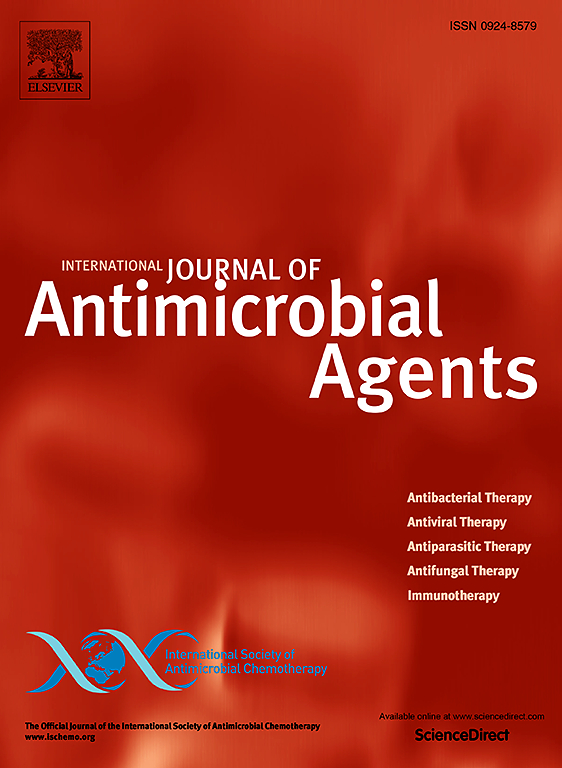基于干扰素的最佳抗病毒策略在未成年慢性乙型肝炎患者:倾向评分加权队列研究。
IF 4.6
2区 医学
Q1 INFECTIOUS DISEASES
International Journal of Antimicrobial Agents
Pub Date : 2025-09-10
DOI:10.1016/j.ijantimicag.2025.107618
引用次数: 0
摘要
背景:儿童慢性乙型肝炎(CHB)的有效治疗是实现消除乙型肝炎目标的关键。本研究旨在评估不同干扰素(IFN)抗病毒策略在CHB儿童中的实际疗效和安全性。方法:纳入ALT或天冬氨酸转氨酶(AST)升高和HBV DNA可测的CHB儿童。进行倾向评分加权分析,血清乙型肝炎表面抗原(HBsAg)损失率是主要的结局指标。结果:共纳入809例患者,并根据不同的抗病毒方案进行分组,其中IFN单药治疗163例,IFN核苷类似物(NA)序贯治疗325例,IFN与NA联合治疗321例。平均年龄5.9±4.0岁。中位随访时间为78.4个月。广义重叠加权分析显示,新生IFN与NA联合治疗和IFN单药治疗优于IFN-NA序贯治疗,但IFN单药治疗与新生IFN与NA联合治疗无显著差异(P=0.5999)。在敏感性分析中,治疗加权逆概率的结果与广义重叠加权的结果一致,但在使用粗数据的多变量分析中,IFN单药治疗与IFN- na序贯治疗之间无显著差异(P=0.0605)。未见严重不良事件发生。结论:在这项涉及迄今为止最大的未成年CHB患者样本的队列研究中,IFN-NA序贯治疗虽然是常用的,但在HBsAg清除方面似乎不是最佳的。我们的结果一开始就倾向于IFN和NA的结合。本文章由计算机程序翻译,如有差异,请以英文原文为准。

Interferon-based optimal antiviral strategies in underage patients with chronic hepatitis B: A propensity score-weighted cohort study
Objectives
Effective treatment of chronic hepatitis B (CHB) in childhood is critical to achieve the goal of eliminating hepatitis B. This study aims to assess the real-world efficacy and safety of different interferon(IFN)-based antiviral strategies in CHB children.
Methods
CHB children with elevated ALT or aspartate aminotransferase (AST) and measurable HBV DNA were included. A propensity score weighted analysis was performed and rate of serum hepatitis B surface antigen (HBsAg) loss was the main outcome measure.
Results
Totally, 809 patients were enrolled and divided according to different antiviral regimens, including 163 with IFN monotherapy, 325 with IFN-nucleos(t)ide analogues(NA) sequential therapy and 321 with de novo IFN and NA combination therapy. Mean age were 5.9 ± 4.0 years. Median follow-up time was 78.4 months. Generalized overlap weighting analysis showed that de novo IFN and NA combination therapy and IFN monotherapy were better than IFN![]() NA sequential therapy but that no significant difference (P = 0.5999) existed between IFN monotherapy and de novo IFN and NA combination therapy. In the sensitivity analysis, the outcomes from inverse probability of treatment weighting were consistent with those from generalized overlap weighting, but no significant difference (P = 0.0605) was revealed between IFN monotherapy and IFN
NA sequential therapy but that no significant difference (P = 0.5999) existed between IFN monotherapy and de novo IFN and NA combination therapy. In the sensitivity analysis, the outcomes from inverse probability of treatment weighting were consistent with those from generalized overlap weighting, but no significant difference (P = 0.0605) was revealed between IFN monotherapy and IFN![]() NA sequential therapy in the multivariable analysis using crude data. Serious adverse events were not observed among the patients.
NA sequential therapy in the multivariable analysis using crude data. Serious adverse events were not observed among the patients.
Conclusions
In this cohort study involving the hitherto largest sample of underage CHB patients, IFN![]() NA sequential treatment, though it is commonly used, seems suboptimal in HBsAg clearance. Our results favour the combination of IFN and NA at inception.
NA sequential treatment, though it is commonly used, seems suboptimal in HBsAg clearance. Our results favour the combination of IFN and NA at inception.
求助全文
通过发布文献求助,成功后即可免费获取论文全文。
去求助
来源期刊
CiteScore
21.60
自引率
0.90%
发文量
176
审稿时长
36 days
期刊介绍:
The International Journal of Antimicrobial Agents is a peer-reviewed publication offering comprehensive and current reference information on the physical, pharmacological, in vitro, and clinical properties of individual antimicrobial agents, covering antiviral, antiparasitic, antibacterial, and antifungal agents. The journal not only communicates new trends and developments through authoritative review articles but also addresses the critical issue of antimicrobial resistance, both in hospital and community settings. Published content includes solicited reviews by leading experts and high-quality original research papers in the specified fields.

 求助内容:
求助内容: 应助结果提醒方式:
应助结果提醒方式:


